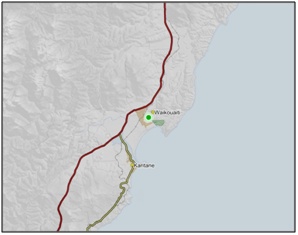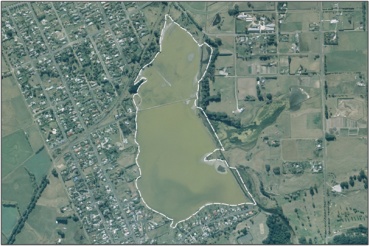- Presence of shore cotula (Leptinella dioica), rekoreko (Selliera radicans), sea primrose (Samolus repens) and cutty grass/rautahi (Carex geminata). 34
- Most of the lagoon is part of the Hawksbury Wildlife Reserve. An adjacent lagoon which is not included within the wetland's mapped boundary is part of the Coastal Protection Area covered by the Regional Plan: Coast. 1
- Listed as an Area of Significant Conservation Value in the Dunedin City District Plan. Described as two lagoons fed by channel, dissected by causeways. Natural values include wetland habitat values for native bird and fish species. Described as of regional significance. 28
- 121 plant species have been recorded: 43 local natives and 5 non-local natives, the remained being exotic. Two species are classified as nationally uncommon: Gossamer grass (Anemanthele lessoniana), which is 'at risk-declining' and golden sand sedge/Pikao (Desmoschoenus spiralis), which is 'at risk-relict'. Other native rushes and sedges recorded include jointed wire rush/oioi (Leptocarpus similis), cutty grass/rautahi (Carex geminata), knobby clubrush/wiwi (Ficinia nodosa), leafless rush (Juncus distegus), Juncus edgariae, salt marsh ribbonwood/houi (Plagianthus divaricatus) and sea primrose/maakoako (Samolus repens). 83
- Nationally threatened and uncommon birds recorded include Grey Duck (Anas superciliosa) , nationally critical; White Heron (Egretta alba modesta), nationally critical; Eastern Falcon (Falco novaeseelandiae "eastern"), nationally vulnerable; Variable Oystercatcher (Haematopus unicolor), at risk - recovering; Australasian Pied Stilt (Himantopus himantopus leucocephalus), at risk - declining; Caspian Tern (Sterna caspia), threatened - nationally vulnerable; Black-billed Gull (Larus bulleri), threatened-nationally endangered; Red-billed Gull (Larus novaehollandiae scopulinus), threatened - nationally vulnerable; Black Shag (Phalacrocorax carbo novaehollandiae), at risk - naturally uncommon; Little Shag (Phalacrocorax melanoleucos brevirostris), at risk - naturally uncommon; Little Black Shag (Phalacrocorax sulcirostris), at risk - naturally uncommon; and Royal Spoonbill (Platalea regia), at risk - naturally uncommon. 83
- Freshwater fish species recorded include eels, inaka (Galaxias maculatus) and bully (Gobiomorphus sp.). 83
- The lagoon also provides important habitat for common waterfowl species such as New Zealand Shoveller/Kuruwhengi (Anas rhynchotis variegata), Paradise Shelduck (Tadorna variegata), Grey Teal (Anas gracilis), Black Swan (Cygnus atratus) and Mallard (Anas platyrhynchos). 83
-
-
-
-
-
-
-
-
-
-
-
-
-
Hawksbury Lagoon
-
-
-
-
-
-
-
-
-
-
-
-
-
-
-
-
-
-
Hawksbury Lagoon
Description:
A shallow fresh-brackish water lagoon at the mouth of the river, adjacent to the town of Waikouaiti. Little tidal influence within the lagoon as a causeway along the channel entrance restricts the entry of seawater. 1
Type/Class:
Saltmarsh 2
Size:
43.3 ha.
Altitude:
0-20 m above sea level.
Approximate location:
North of Stewart Street, Waikouaiti.
NZTM (centre point): E1418600 N4947400
Regional Plan: Water for Otago.
Schedule 9 Regionally Significant Wetland, no.58, Map F56.
Territorial Authority:
Dunedin City Council

Recorded Values:
Value |
Description |
|
|---|---|---|
A4 |
High degree of wetland naturalness. | |
A5 |
Scarce in Otago in terms of its ecological or physical character. | |
A6 |
Highly valued by Kai Tahu for cultural and spiritual beliefs, values and uses, including mahika kai and waahi taoka. 1 The wetland is of cultural importance to Kai Tahu as a mahika kai site where fish (especially eels and whitebait/inaka (Galaxias spp.)) and waterfowl were traditionally harvested 1 | |
A7 |
|
|
A8 |
Regionally significant wetland habbitat for waterfowl. "1" | |
A1 - A3, A9 |
No relevant information is currently held by the ORC. |
Other Information:

Aerial View of Hawksbury Lagoon (March 2006)
References:
1 Otago Regional Council (2004) Regional Plan: Water for Otago. Published by the Otago Regional Council, Dunedin.
2. Ausseil, A.G., Newsome, P., Johnson, P, (2008) Wetland Mapping in the Otago Region. Landcare Research Contract Report prepared for the Otago Regional Council.
28. Dunedin City Council (1999) Dunedin City District Plan. Published by the Dunedin City Council, Dunedin.
34. Correspondance with S. Rate, Senior Ecologist - Wildland Consultants Ltd. (2009) Document ID A168477.
83. Wildland Consultants (2009) Ecological Management Plan for Hawksbury Lagoon, Waikouaiti. Report prepared for Hawksbury Lagoon Inc.
